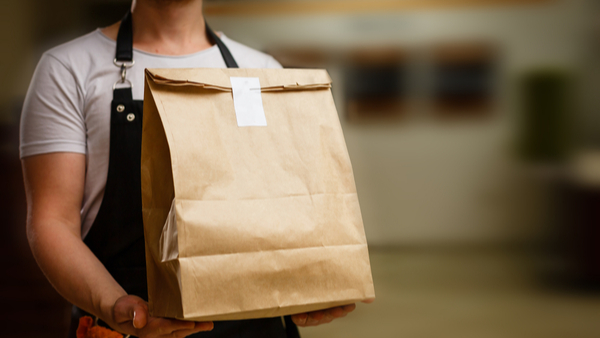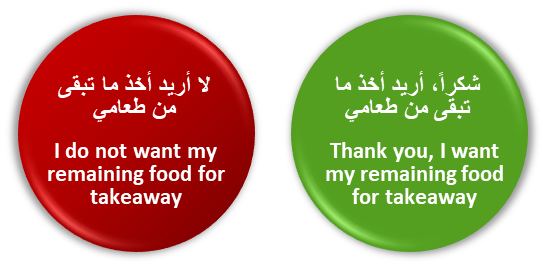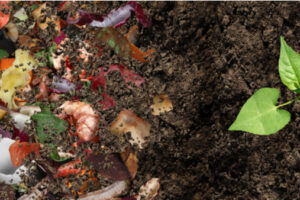Increasing the Demand for Leftover Food

Executive Summary
Nudge Lebanon in collaboration with a group of students enrolled in a Behavioral Economics course jointly offered with the American University of Beirut, designed an intervention to increase the demand for leftover food among dine-in customers of a fast food chain restaurant in the Hamra area of Beirut. Diners’ tables had two-sided colored tokens placed visibly on them, with one side (green) signaling to waiters that the diners would like to have their leftovers packed for takeaway, and the other side (red) declining that option. While the intervention led to a 26% increase in demand for leftover food relative to the baseline, the results were not statistically significant, due to the context of the intervention, mainly the type of food (fast food), the size of portions, and the social norm.
Problem
About one-third of the world’s food produced for human consumption – approximately 1.3 billion tons worth almost $1 trillion – is lost or wasted every year, posing serious concerns at the economic, environmental, social, as well as overall food security levels. Not only does food loss and waste (henceforth “food waste”) contribute to the squandering of resources such as water, energy, land, and capital, but also to the emission of greenhouse gases that lead to global warming and climate change. [1]
While food waste occurs across the whole food chain, around 35% is generated at the consumer level, driven largely by consumers’ values, behaviors, and attitudes.[2] For instance, in Lebanon, food waste constitutes more than 50% of the total household solid waste,[3] with a recent survey revealing that 42% of Lebanese households throw away at least 250 g of consumable food each week.[4]
An additional source of food waste in Lebanon is leftovers on customers’ plates, or what is typically referred to as plate waste. In fact, it is estimated that 3 out of 9 plates served in Lebanese restaurants end up being wasted.[5]
To address the latter issue, Nudge Lebanon in collaboration with a group of students enrolled in a Behavioral Economics course jointly offered with the American University of Beirut, designed an intervention to increase the demand for leftover food among dine-in customers of a fast food chain restaurant in Hamra.
Intervention
The pre-post pilot intervention consisted of a two-sided colored token – green on one side and red on the other (see Figure 1) – that was placed in a visible area on the dining tables of the restaurant.[6] Placing the token green side up signaled to waiters that the diners would like to have their leftover food packed to be taken away; while placing it on the red side signaled to the waiters otherwise.

The intervention was divided into two consecutive periods: a) a baseline period in which the demand for leftover food was measured, and b) an intervention period, whereby the token was placed with the green side up by default.
The purpose of the intervention was twofold:
A. To default customers into taking their food away, thereby saving them the trouble (and oftentimes the embarrassment) of actively asking the restaurant staff for this service;
B. To reduce the social stigma associated with taking away leftover food, by gradually making such behavior the new norm.
Results
Data was collected by recording the number of tables that opted to take their food away, 3 days a week (Monday to Wednesday) between 8:00 p.m. and 10:30 p.m., over a period of 5 weeks. In addition, the team collected data on the size (number of diners), type (date, friends, or family), and composition (proportion of men to women) of participants in the intervention to control for such variables.
In total, 256 tables were observed (147 during the baseline; 120 during the intervention period), of which 61 had leftovers (circa 24%).[7] On average, the intervention led to a 26% increase in the demand for leftover food, relative to the baseline period (among the tables with leftover plates). However, these results were not statistically significant.[8] Moreover, none of the control variables (size, type or composition) were predictive of the likelihood of taking leftovers away.
Conclusion
Overall, the intervention was not as successful at reducing food waste as similar experiments conducted by NudgeItalia in Milan – and later by the Qatar Behavioural Insights Unit[9] in Doha – further reaffirming that context matters.
Several reasons were identified. One, the portions of meals served at the restaurant in Beirut were relatively modest, resulting in fewer instances with leftover food – hence the small sample size. Two, the type of meals offered did not lend itself to being taken away (a typical meal consisted of a burger, fries, and coleslaw). Three, the rigidity of cultural norms in Beirut, whereby taking away leftover food is still not considered in vogue.
In conclusion, future replications of this intervention should take into account the type and portions of food served at a given establishment. For instance, the intervention might have better chances of success at a restaurant that serves Lebanese food, where diners are known to order more food than they could consume. Moreover, future interventions should employ behavioral tools to tackle the ingrained cultural norms, as well as to reduce the amount of food ordered.
Endnotes
[1] Retrieved from http://www.fao.org/food-loss-and-food-waste/en/.
[2] Bond et. al. (2013). Food waste within global food systems. A Global Food Security Report.
[3] Ministry of Environment, Nationally Appropriate Mitigation Action in Lebanon’s Municipal Solid Waste Sector Report. Retrieved from http://climatechange.moe.gov.lb/waste.
[4] Charbel, L., Capone, R., Grizi, L., Debs, P., Khalife, D., & Bilali, H. E. (2016). Preliminary insights on household food wastage in Lebanon. Journal of Food Security, 4(6), 131-137.
[5] Retrieved from http://foodblessed.org/MaBadda2iste7a/.
[6] The intervention was inspired by an experiment carried out by NudgeItalia at a pizzeria near Milan. For more information, check out: http://tenudge.eu/project/using-the-default-rule-to-increase-the-demand-of-doggy-bags-in-restaurants/.
[7] Leftovers were defined as plates containing a notable amount of food at the time of dinner completion (at least one-third of the size of the plate). Side orders (salads, fries, coleslaw) were not taken into account due to the impracticality of packing them alone, and to their shorter longevity of satisfactory taste.
[8] Both a logistic regression and Fisher test revealed insignificant results.
[9] The interventions increased the demand for leftover food by 44% and 42%, respectively.



